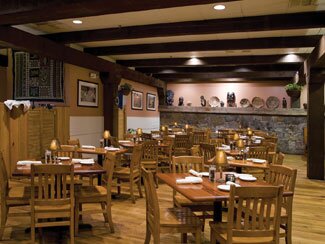FOOD- THE EATER- African pub: You're sported if not transported

The Shebeen
PHOTO BY RYAN HOOVER
Vinegar Hill's Shebeen restaurant bills itself as "A South African-style pub," and as such has little to live up to with regard to authenticity in the eyes of most local patrons. I confess I've been in South Africa exactly twice, passing through on the way to and from Botswana, and mostly saw the neighborhood of the Johannesburg airport. Those brief sojourns did little to prepare me for what I might expect here.
The name derives from the Gaelic sibin, itself the object of etymological squabbles but generally interpreted to mean an "illegal drinking spot." And in Apartheid-era South Africa, a shebeen was a mostly illegally operated pub for the disenfranchised natives who were unwelcome in English or Boer drinking establishments. Post-Apartheid, the shebeen tradition seems to have a legal, culturally important role. The Shebeen of Charlottesville claims to have more in common with Cape wineries than "the illicit beer hall."
But I think I'm too busy describing what our local Shebeen is not. It is a good place to eat and drink, with private, well-shaded, outdoor deck seating in season and a comfortably appointed and welcoming pub and dining room. The cuisine is South African, a comfort-based evolution of English and Dutch fare that politely welcomes African, Malaysian, Indian, and other trade-route and British Empire flavors, without giving any of these run of the show. That said, it's not impossible to obtain a perfectly run-of-the-mill American bar meal there, either.
With the exception of the tasty lamb-based shepherd's pie– somewhat overpriced at $16– and berry-topped melktert dessert, we preferred the dishes that represent African, Asian, and Indian influences. There are triangular Indian-spiced lamb- and beef-filled samosas, a hearty and delicious appetizer served with an orange sweet-mango chutney that does duty across the menu. The grilled Malaysian-style satay is also nice, served with peanut sauce and more chutney.
Lamb roams liberally through the menu. My personal favorite was the Lamb Curry Potjie, a cast-iron pot of dark savory curry with potatoes, green beans, cabbage, and eggplant. I layered the accompanying saffron rice and steamed pub vegetables into every bite and used the corn-based monkeybread to sop up the dregs, appreciating the long simmering that had tenderized and infused the lamb to spoon-cut stew-style perfection.
The braised lamb shank we tried at a later visit wanted more simmering and a cozier relationship with its port wine reduction sauce. The art of braising requires that tougher cuts be simmered long past the initial point of doneness, until moderate heat– preferably in a nicely flavored liquid– softens the meat to the point that a knife is unnecessary. The sauce seemed to have been applied to the shank after a bland and incomplete braising process.
The sosatie, chunks of lamb marinated in mango chutney and spiced with turmeric and tamarind, then skewered on spikes of sugarcane and grilled on the brai (served with stewed green lentils with a hint of curry, cucumber-mint yogurt sauce, and saffron rice), seems like an authentic expression of the best traditions in the amalgam of South African cuisine.
Durban Spiced Chicken is a cane-skewered chicken variation (with cardamom and cumin in the dry-rub) served with mealie pap, delicious and ever-so-slightly-sour "South African grits" made from millet, which– if the Shebeen's saffron rice and mashed potatoes weren't both very nice and tasty starch accompaniments– would get our vote for "side of choice" by virtue of its uniqueness.
The distinctive South African menu items aren't cancelled out by more standard bar-fare like fried calamari, Greek salad, soup in a boule, and peri-peri chicken wings (which are good, quite spicy, but not so different from other good spicy chicken wings; served with– you guessed it– celery and blue cheese dressing). Instead, the appeal is broadened; family and student groups abound.
Smoking is allowed in The Copper Bar (which is not completely separate from the main dining area, but up two steps at the front of the restaurant, and where, by the way, they pull clean imperial pints of Boddington's and Guinness, and pour from a selection of South African wines) and on the deck outside, which draws a fairly civilized older crowd who seem to be able to hold their liquor.
On a recent winter night's visit, we had a pint in the bar while we waited for a booth (even though there were a couple of center tables open). Rugby and boxing matches monopolized two flat screen televisions above the busy bartender. When the booth opened, we descended to the dining room, where heavy oak beams and cherry-topped tables with amber-bead candle shades blend with traditional South African masks, bowls, baskets, and safari photographs.
Grad students and their bohemian professor drank wine and settled in for a lingering meal at a back table. A mother finished discreetly nursing her infant and made a somewhat premature exit precipitated by their innocuously rambunctious elder son, as her husband paid the bill and chugged the better part of his newly delivered wine. Silver-haired financial analysts in navy blazers dined course by course at a table nearby, oblivious to any perceived hubbub; they were there when we arrived and there when we left.
I can't say that I feel any more like I've visited South Africa. But I know I've visited one of the better pubs in town.
#